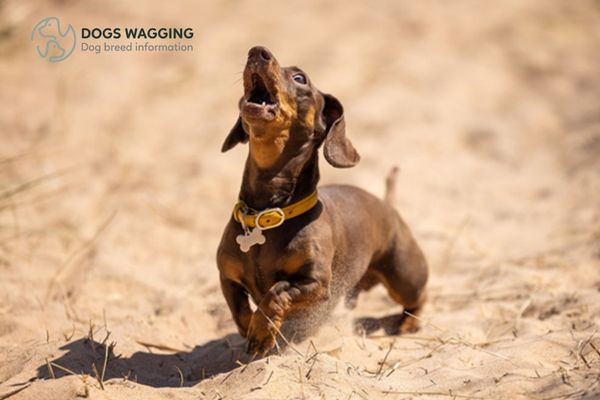John Switch • Tue Feb 20 2024
Why Dachshunds Are The Worst Breed: All Reasons

If you're a dog lover, you may find Dachshunds irresistibly cute with their low bodies and wagging tails. However, despite their adorable appearance, Dachshunds are often considered challenging for various reasons. In this article, we'll find out why Dachshunds are the worst breed and what you can do to deal with their problems.
> READ MORE:
- Border Collie Dachshund Mix: Dog Breed Information And Pictures
- Why Boxers Are The Worst Dogs: Top 8 Reasons
What Is a Dachshund Dog Breed?
Learn about the Dachshund Dog Breed by exploring its history, appearance, and personality traits to gain a comprehensive understanding.
The Origin
Dachshunds originated in 15th-century Germany, where two sizes were bred for specific hunting purposes. The Standard Dachshund was bred to flush out badgers, while the Miniature Dachshund specialized in hunting rabbits. In the United States, they were also used for hunting prairie dogs and tracking deer. The name "Dachshund" means badger dog in German, reflecting their hunting role. In modern Germany, they are known as Dackel or Teckel. Their distinctive paddle-shaped front paws aid in digging during hunting. Dachshunds are believed to have been bred from dwarf mutations of larger hunting hounds, gradually developing their unique physique for underground hunting pursuits.
Appearance Traits
Dachshunds, internationally known as the sausage dog. Their distinctive appearance is marked by their being short and big, like a bear’s paw, which captivates attention. With a long nose, Dachshunds possess excellent sniffing abilities. Their unique and funny appearance makes it easy for even new dog parents to recognize their breed.
Despite their short legs, Dachshunds sport long ears that hang down to their eyes and mouth. Notably, they are among the least hairy dog breeds and come in three coat variations: short, long, and smooth. Dachshunds have an average weight ranging from 11 to 32 pounds, and their height typically measures between 5 to 9 inches.
Temperament & Personality Traits
Dachshunds are very intelligent, reflecting their hunting dog heritage, making them sly and quick learners. Their ability to absorb and remember commands surpasses breeds like Samoyed and Husky. Training Dachshunds can pose challenges due to their inherently high-spirited nature, leading to strong and sometimes aggressive reactions when they perceive danger.
Despite their bold character, Dachshunds display deep affection and loyalty towards their owners. From a young age, they exhibit friendliness, affection, and liveliness, forming strong bonds with their human companions. Similar to many dogs, Dachshunds have a penchant for barking. Their bark is notably loud and can be quite resonant.
Why Dachshunds Are the Worst Breed?
Before you decide to get a Dachshund, you should be aware of the challenges and drawbacks of owning this breed.
Noise and Destructive Behaviors
Dachshunds can pose challenges with their noisy and destructive behaviors while they are charming and loyal.
Barking and Hunting Behaviors
Dachshunds have large lungs and robust voices that produce surprisingly loud and frequent barking. Their barks serve multiple purposes, from alerting potential threats to expressing excitement or frustration. Their strong hunting instinct prompts them to chase and bark at moving objects like squirrels, birds, or cars.
To manage their barking, ample exercise, mental stimulation, and socialization are crucial. Teaching the "quiet" command and rewarding silence with treats or praise helps. Positive reinforcement, avoiding yelling, and using deterrents like citronella collars or noise devices can be effective, but they should be employed as a last resort.
Digging and Gnawing Tendencies
Dachshunds exhibit a love for digging and chewing driven by various instincts and reasons. Digging serves purposes like following prey, hiding food, cooling off, escaping, or battling boredom. Chewing is prompted by the need to explore, soothe gums, release stress, seek attention, or simply have fun. With strong jaws and teeth, Dachshunds can inadvertently damage furniture, shoes, clothes, or plants.
To curb these tendencies, you must provide them with physical and mental stimulation. Offering suitable toys and chews, regularly rotated for sustained interest, helps redirect their behavior. Keep valuables out of reach, use bitter deterrents on furniture and plants, and monitor signs of anxiety or boredom. Praising and rewarding positive behavior with toys and chews reinforces good habits, while redirection is key when they engage with inappropriate items.
Common Health Issues
You need to know about these potential health problems and how to keep your Dachshunds healthy and happy.
Back Problems in Dachshunds
Dachshunds' distinctive elongated spine makes them susceptible to back problems, with intervertebral disc disease (IVDD) being a prevalent and serious concern. IVDD occurs when spinal discs between vertebrae damage and compress the spinal cord, leading to pain, weakness, paralysis, and, in severe cases, death. Trauma, aging, genetics, and obesity can contribute to IVDD, with Dachshunds being ten times more prone than other breeds.
Maintaining a healthy weight, preventing jumping on/off furniture or stairs, offering a supportive bed, and limiting low-impact exercise can reduce IVDD risks. Monitoring signs of back pain like reluctance to move, shivering, or an arched back is crucial. If symptoms arise, immediate veterinary attention is necessary. Treatments may include painkillers, anti-inflammatory drugs, steroids, surgery, or, in some cases, mobility aids like wheelchairs.
Dental Problems in Dachshunds
Dachshunds commonly face dental problems due to their small mouths and crowded teeth, making them more susceptible to plaque, tartar, gingivitis, and periodontal disease. These issues can lead to bad breath, tooth loss, infections, and pain. Furthermore, if bacteria enter the bloodstream, dental problems can impact vital organs like the heart, liver, and kidneys.
To ward off dental disease, daily tooth brushing with dog-friendly toothpaste and a toothbrush is essential. Providing dental chews, toys, and treats aids in cleaning teeth and massaging gums. Regular veterinary check-ups and professional cleanings are crucial to promptly identify and address dental concerns. In cases of severely crowded or damaged teeth, extractions may be recommended by the vet.
Other Common Health Problems
Aside from back and dental issues, Dachshunds may face additional health concerns:
- Hip Dysplasia: A genetic condition affecting the hip joint, leading to arthritis, pain, and lameness. Diagnosis involves X-rays, with treatment options including medication, physical therapy, weight management, or surgery.
- Patellar Luxation: The kneecap slips out of its groove, resulting in limping, pain, and inflammation. Diagnosed through physical examination, treatment may include medication, rest, or surgery.
- Obesity: Excessive body weight causes health issues like diabetes, heart disease, and joint problems. Prevention and treatment involve a balanced diet, measured portions, limited treats, and increased exercise.
- Eye Problems: Conditions like cataracts, glaucoma, progressive retinal atrophy, and dry eye may cause vision loss, pain, and irritation. Treatment options include medication, eye drops, or surgery.
Training Challenges
Training Dachshunds poses challenges, especially in housebreaking. Discover these tips for success and strategies to overcome common problems.
Stubbornness and Self-reliance
Initially bred for hunting, Dachshunds exhibit bravery, independence, and persistence, making them inherently stubborn and resistant to training. They tend to think for themselves and prioritize their desires over commands. During training, they may quickly become bored or distracted, losing interest in learning new skills.
To successfully train a Dachshund, patience, firmness, and consistency are essential. You must set yourself up as the leader, gain respect, and make training enjoyable. Positive reinforcement using treats, praise, and toys is effective, while harsh punishments like yelling or hitting can induce fear, aggression, or increased defiance.
Consistent Training and Positive Reinforcement
Sensitive and emotional, Dachshunds thrive on love, attention, consistency, and positive reinforcement for effective learning and good behavior. You need to provide clear communication as Dachshunds may be confused or discouraged by mixed signals, unclear expectations, or negative feedback that leads to the development of undesirable habits like barking or chewing.
Training success requires being clear, concise, and consistent, using the same words, tone, and gestures for each command. Repetition aids understanding, while consistent rewards for correct actions and ignoring or redirecting undesirable behavior form the foundation of positive reinforcement. Refraining from rewarding bad behavior, regardless of cuteness, is vital to prevent its recurrence.
Early Socialization
Dachshunds may not naturally be very friendly or sociable, often displaying wariness toward strangers. To enhance their friendliness and sociability, you should introduce them positively to various people of different ages, ethnicities, and appearances, avoiding any actions that might scare or force them. Basic command training, such as sit, stay, come, and leave, helps instill obedience and correct unwanted behaviors like barking or jumping while praising positive actions that contribute to a more well-behaved and sociable Dachshund.
Aggression with Other Animals
Dachshunds can exhibit aggression towards other dogs due to their strong prey drive and possessive tendencies. This aggression may manifest through barking, growling, or biting, particularly with larger or unfamiliar dogs. To address this behavior, early socialization is crucial. Introduce your Dachshund to various dogs and teach proper behavior. Supervise interactions and intervene if signs of aggression arise. Utilize leashes, muzzles, or crates when necessary. Spaying or neutering your Dachshund can also help reduce hormonal and territorial impulses, contributing to a more harmonious relationship with other animals.
Prone to Separation Anxiety
Known for their strong attachment to owners, Dachshunds may struggle with separation anxiety when left alone. This condition triggers panic behaviors, including barking, howling, chewing, and attempts to escape. To manage this anxiety:
- Establish a routine and calm departure and return actions.
- Provide a cozy space with familiar items, engage in pre-departure play, and introduce background noise like radio or TV.
- Gradually extend alone time, starting with short durations.
- For severe cases, consult a vet for potential medication or calming solutions.
Do Dachshunds Good for Families with Kids?
Dachshunds, known for their stubbornness, might display aggression, especially towards small children. Their low tolerance for rough play can potentially result in injuries, making them less suitable for families with small children. Due to these traits, families with kids may need to carefully assess whether Dachshunds align with their lifestyle and ability to manage the interactions between the dog and the children.
Are Dachshunds Suitable for First-time Dog Owners?
Dachshunds are recognized for their stubbornness, demanding considerable patience and persistence during training. Housebreaking them can be challenging, especially for first-time dog owners, due to their obstinate demeanor. Their strong prey drive poses difficulties in controlling them outdoors, making it challenging for inexperienced dog owners to manage Dachshunds effectively during walks or playtime.
While Dachshunds make loving companions, they may not suit every family. Their need for attention and care and their stubborn tendencies can be particularly challenging for first-time dog owners and families with small children. First-time dog owners might find more suitable options by considering breeds that better align with their lifestyle and experience level.
Conclusion: Why Dachshunds are the worst breed?
Understanding why Dachshunds are the worst breed is crucial for potential owners. While they may not be the ideal choice for everyone seeking a low-maintenance or easy-going pet, those who appreciate their unique personality and charm can find joy in raising a Dachshund. Preparing for the challenges, seeking professional advice, and connecting with fellow Dachshund owners are essential steps in ensuring a fulfilling and responsible ownership experience. Remember, the right approach can turn these spirited dogs into loving and loyal companions.

John Switch / Author
Hello this is a test author
Recent blog posts

John Switch • Thu Feb 22 2024
Akita Mix With Rottweiler: All Facts You Should Know
The Akita Mix With Rottweiler is a combination of purebred Akita and purebred Rottweiler. These dogs are very loyal, devoted, and intelligent. They require

John Switch • Fri Dec 29 2023
American Corgi: All Facts You Need to Know
An American Corgi are a mixed dog which is result of crossing two different breeds: the Cardigan and the Pembroke Welsh. Let's explore the allure of the Am

John Switch • Fri Feb 23 2024
All Things About Anatolian Shepherd: Traits, Health Cares
Do you want to know more about Anatolian Shepherd Dogs? They originated in Turkey, where they were bred to be protectors of shepherds' livestock. They are a

John Switch • Tue Feb 27 2024
Australian Cattle Dog Behavior Issues You Should Know
What are Australian Cattle Dog Behavior Issues? - Australian Cattle Dogs are famous for behavioral issues, such as destructive behavior, nuisance barking, d
 Dachshunds originated in 15th-century Germany, bred for hunting badgers and burrow-dwelling mammals
Dachshunds originated in 15th-century Germany, bred for hunting badgers and burrow-dwelling mammals Why Dachshunds Are The Worst Breed
Why Dachshunds Are The Worst Breed Dachshunds exhibit noise and destructive behaviors like barking and digging and gnawing tendencies
Dachshunds exhibit noise and destructive behaviors like barking and digging and gnawing tendencies Dachshunds
Dachshunds Training Dachshunds demands patience and consistency due to their stubbornness and independent nature
Training Dachshunds demands patience and consistency due to their stubbornness and independent nature